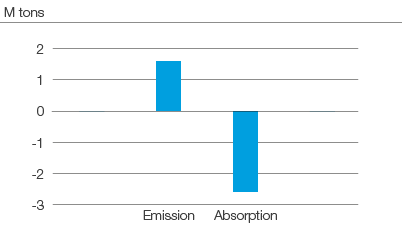Forest management
As Europe’s largest private forest owner, SCA takes a long-term approach to its responsible forest management.
Biodiversity
Around 2 million of SCA’s 2.6 million hectares of forest land are managed for timber production. The remaining 600,000 hectares of less productive forest, bogs and other land are still valuable as a living environment for flora and fauna.
Areas that provide vital habitats for sensitive fauna and flora are exempted from forest management or are managed with the aim of enhancing the existing environmental values and biodiversity. Approximately 200 species in SCA’s forests – over 100 species of insects, nearly 50 types of fungi and about 50 different kinds of mosses and lichens – are disadvantaged by forest management and require special consideration.
SCA has set aside nearly 7% of its managed forests to benefit biodiversity in its ecological landscape plans. SCA also takes extensive conservation measures in managing forest areas that do not contain any particular conservation value. During felling operations, individual trees, groups of trees and buffer zones are set aside to ensure that the conservation values inherent in older forests are preserved and become an integrated part of the new growing forest. In 2015, 14% of the 18,000 hectares planned for harvesting were preserved for nature consideration.
Seedlings
In 2015, SCA’s forest-tree nursery produced 86 million seedlings, of which 43% were planted in SCA’s own forest land. The remainder of the seedlings were sold to other forest owners.
Conservation parks
In 2015, two conservation parks comprising more than 4,000 hectares of forests deemed to be rich in biodiversity and cultural heritage were inaugurated in Sweden: Njurunda coast and Märlingsberget. At least half of the woodland areas in the conservation parks must be earmarked for or managed in a manner that promotes nature conservation and cultural values. SCA is also using the knowledge it has gained in these parks in its other forest operations. In total, SCA now has five conservation parks comprising more than 10,000 hectares.
Forest management and certifications
In 2015, SCA used a total of 11.1 million cubic meters of wood raw material, of which 54% was timber from own forests and chips from own sawmills.
SCA’s forests are managed in line with the Forest Stewardship Council’s (FSC®) ambitious standard for responsible forest management. In the 2015 FSC audit, the auditors found that SCA complies with the FSC forest management standard in a responsible manner. Eight minor CARs (Corrective Action Required) and four observations were noted. These included a request to ensure routines for consultation opportunities for relevant Sami communities in connection with forestry operations and that procedures for quarry operations are met. These CARs and observations will be followed up in the 2016 audit.
SCA’s forests are also certified in line with the Programme for the Endorsement of Forest Certification (PEFC™) and the Group conducts controls based on both of these standards. SCA’s forest management has been ISO 14001 certified since 1998.
Forest as carbon sinks
SCA’s carbon dioxide emissions from own production and absorption in SCA’s forests

The net uptake of carbon dioxide in SCA’s forests is about 2.6 million tons, exceeding the carbon dioxide emissions from fossil fuel of 1.6 million tons generated by all of the Group’s production.
SCA’s 2.6 million hectares of actively and responsibly managed forests provide an impressive carbon sink. Young, growing trees need 1.3 tons of carbon dioxide to produce each cubic meter of wood, making them one of the most effective means to reduce carbon dioxide levels in the atmosphere. SCA forests have a net growth of 1%, resulting in a net carbon sequestration of SCA’s forests equivalent to 2.6 million tons annually. If half of the world’s forests were managed like SCA’s and deforestation was stopped, much of the climate change problem would be solved.
